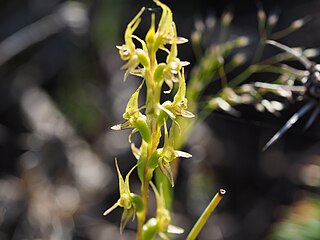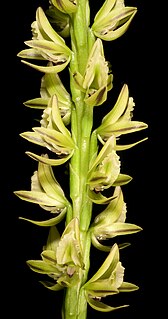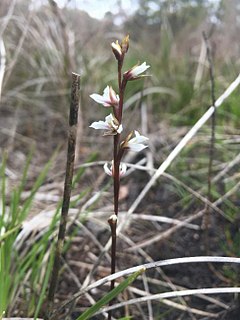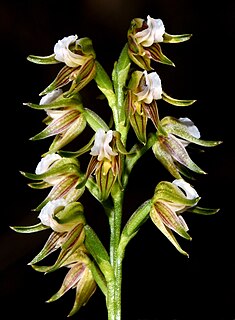
Prasophyllum, commonly known as leek orchids, is a genus of about 140 species of flowering plants in the orchid family, Orchidaceae and is found in Australia and New Zealand. The Australian species are found in all states but have not been recorded in the Northern Territory. The common name arises from their having a hollow, leek- or onion-like leaf. Some species only flower after summer fires and have flowers similar to those of Xanthorrhoea which flower at the same time, suggesting that they employ the same pollinating insects. Leek orchids are similar to those in the genus Genoplesium except that the free part of the leaf is cylindrical and the labellum has a solid connection to the column. They range in size from the little laughing leek orchid at about 15 cm (6 in) to the king leek orchid which grows up to 2 m (80 in) tall.

Prasophyllum gracile, commonly known as the little laughing leek orchid, is a species of orchid endemic to the south-west of Western Australia. It is one of the most common and widespread orchids in the south-west and has a single smooth, tube-shaped leaf and up to forty or more, usually yellowish-green flowers.
Prasophyllum australe, commonly known as the southern leek orchid or austral leek orchid, is a species of orchid and is endemic to south-eastern Australia. It has a single tubular, green leaf and up to fifty scented, greenish-brown flowers with red stripes.

Prasophyllum fimbria, commonly known as the fringed leek orchid, is a species of orchid endemic to the south-west of Western Australia. It is a tall orchid with a single smooth, tube-shaped leaf and up to seventy greenish-brown flowers with a white and pink labellum.

Prasophyllum brownii, commonly known as the Christmas leek orchid, is a species of orchid endemic to the south-west of Western Australia. It is one of the last of the genus in Western Australia to flower and has a tall flowering stem with up to eighty pale green and fawn-coloured flowers.
Prasophyllum cucullatum, commonly known as the hooded leek orchid, is a species of orchid endemic to the south-west of Western Australia. It is a tall orchid with a single smooth, tubular leaf and up to fifty or more purplish-red and white flowers with a frilled labellum crowded along a relatively short flowering stem.

Prasophyllum cyphochilum, commonly known as the pouched leek orchid, is a species of orchid endemic to the south-west of Western Australia. It is a relatively common orchid with a single smooth, tubular leaf and up to thirty or more pale yellow and brown flowers. The flowers do not open fully, are more or less cup-shaped and have a "humped" labellum.
Prasophyllum brevilabre, commonly known as the Gorae leek orchid, is a species of orchid endemic to south-western Victoria. It has a single tubular, green leaf and up to forty greenish-brown flowers with reddish markings. It is a very rare orchid, now only known from two small, scattered populations. It was first recorded from Gorae West near Portland but is no longer found there.
Prasophyllum drummondii, commonly known as the swamp leek orchid, is a species of orchid endemic to the south-west of Western Australia. It is a late-flowering species with a single tubular leaf and up to thirty brownish-orange or pale yellow flowers and often grows in standing water.
Prasophyllum gibbosum, commonly known as the humped leek orchid, is a species of orchid endemic to the south-west of Western Australia. It is a late-flowering leek orchid with a single smooth, tubular leaf and up to eighty or more purplish-red and white flowers with a smooth labellum. It is similar to P. cucullatum but that species has a frilly labellum, usually a shorter flowering stem and an earlier flowering period.
Prasophyllum giganteum, commonly known as the bronze leek orchid, is a species of orchid endemic to the south-west of Western Australia. It is a tall, fragrant leek orchid with a single smooth, tubular leaf and up to fifty or more green and pinkish-purple flowers with a frilly labellum.
Prasophyllum gracillimum, commonly known as the slender leek orchid, is a species of orchid endemic to a small region of Western Australia. It has a single tubular green leaf, and green, brown and white flowers loosely arranged along the flowering stem. This species has not been seen for more than fifty years and is considered by some botanists to be a form of P. fimbria.

Prasophyllum hians, commonly known as the yawning leek orchid, is a species of orchid endemic to the south-west of Western Australia. It is a common, tall leek orchid with a single smooth, tubular leaf and up to fifty or more pink and fawn flowers with a frilly labellum.
Prasophyllum macrostachyum, commonly known as the laughing leek orchid, is a species of orchid endemic to the south-west of Western Australia. It has a single smooth, tube-shaped leaf and up to thirty yellowish-green and purple flowers. It is one of the few Western Australian leek orchids which is not stimulated by summer fires and also has an unusually long flowering period.

Prasophyllum parvifolium, commonly known as the autumn leek orchid, is a species of orchid endemic to the south-west of Western Australia. It is a common species in its range and has a single smooth, tube-shaped leaf and up to eighteen or more green and white flowers with red stripes.
Prasophyllum odoratissimum, commonly known as the scented leek orchid or fragrant leek orchid, is a species of orchid endemic to Western Australia. It has a single smooth, tubular leaf and up to thirty or more scented, greenish, white and fawn-coloured flowers with a labellum which is often bent backwards. It was formerly included in Prasophyllum odoratum.
Prasophyllum ovale, commonly known as the little leek orchid, is a species of orchid endemic to the south-west of Western Australia. It is a small leek orchid with a single smooth, tubular leaf and up to twenty or more white, green and brown flowers with the labellum only slightly upturned.
Prasophyllum plumiforme, commonly known as the dainty leek orchid, is a species of orchid endemic to the south-west of Western Australia. It is a small leek orchid with a single smooth, tubular leaf and up to fifty or more tiny cream-coloured or greenish-yellow flowers on a tall flowering stem.
Prasophyllum robustum, commonly known as the robust leek orchid, is a species of orchid endemic to Tasmania. It has a single tubular, green leaf and up to thirty greenish-brown flowers with a white labellum. It is only known from a single population of about fifty plants, its numbers having been reduced by land clearing.

Prasophyllum subbisectum, commonly known as the Pomonal leek orchid, is a species of orchid endemic to Victoria. It has a single, thin tubular leaf and up to fifteen small, greenish-brown to brown flowers well-spaced along a thin flowering stem. It is only known from a small area around Stawell.









